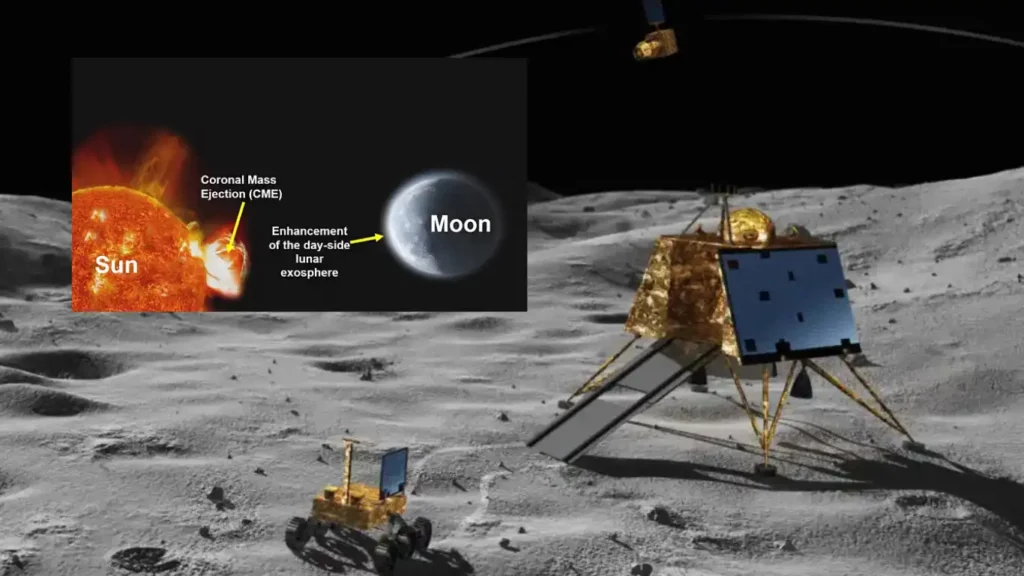New Delhi: In a dazzling display of cosmic detective work, India’s Chandrayaan-2 mission has etched its name deeper into the annals of space exploration. For the first time in human history, scientists have captured irrefutable evidence of how ferocious solar storms—known as coronal mass ejections (CMEs)—rip through the Moon’s whisper-thin veil of gas, the exosphere. This revelation, spearheaded by the Indian Space Research Organisation (ISRO), not only validates long-held theories but also shines a critical light on the harsh realities awaiting future lunar outposts. As space agencies worldwide eye permanent bases on the Moon, this discovery underscores the unpredictable fury of solar activity and its ripple effects on airless worlds.
The breakthrough hinges on data gathered by a sophisticated onboard tool during a once-in-a-blue-moon solar event. It paints a vivid picture of the Moon not as a static rock in the void, but as a dynamic arena where the Sun’s tantrums can temporarily inflate its atmospheric whisper into a fleeting roar. For lunar enthusiasts, ISRO researchers, and anyone tracking the next giant leap for humankind, this is more than science—it’s a wake-up call for the stars.

The Solar Storm That Shook the Moon: A Rare Celestial Encounter
Picture this: On May 10, 2024, the Sun unleashed a barrage of CMEs, colossal bubbles of superheated plasma hurtling through space at millions of kilometers per hour. These weren’t your garden-variety solar sneezes; they were a full-throated eruption from the star’s outer atmosphere, slamming into the Moon with the subtlety of a cosmic freight train. Lacking Earth’s protective magnetic bubble or dense air layer, the Moon absorbed the full brunt, and Chandrayaan-2 was there to witness it.
The mission’s orbiter, circling the lunar south pole like a vigilant sentinel, deployed its Chandra’s Atmospheric Composition Explorer-2 (CHACE-2) instrument to sniff out the aftermath. What it detected was nothing short of revolutionary: a dramatic surge in the Moon’s dayside exosphere, where neutral atoms and molecules multiplied by over tenfold. This wasn’t a gradual creep; it was an explosive uptick in density, pushing total pressure levels to heights unseen in prior readings. ISRO announced the findings on October 18, 2025, during a press briefing in Bengaluru, hailing it as the inaugural empirical proof of CMEs’ lunar footprint.
This event’s rarity can’t be overstated. Solar maxima—the peak of the Sun’s 11-year activity cycle—ramp up CME frequency, but pinpointing one that tags the Moon just right is like threading a needle in the vacuum of space. The 2024 outburst aligned perfectly with Chandrayaan-2’s orbital path, granting CHACE-2 a front-row seat to the chaos.
Demystifying Coronal Mass Ejections: The Sun’s Fiery Temper Tantrums
To grasp this lunar drama, we must first decode the antagonist: coronal mass ejections. These behemoths originate in the Sun’s corona, the wispy, million-degree halo encircling our star. CMEs eject billions of tons of plasma—ionized gas laced with magnetic fields—in explosive outflows that can span the width of the Sun itself.
What sparks them? Twisted magnetic fields in active sunspot regions, often hand-in-hand with solar flares, act as the detonator. These regions are hotspots of solar drama, where field lines snap and reconnect, flinging material outward. During solar maximum, when sunspots proliferate, CMEs become almost routine, numbering in the dozens per month. In quieter solar minima, they’re scarcer, lurking like dormant volcanoes.
Earth feels their wrath routinely: disrupted GPS signals, fried satellite circuits, blacked-out power grids, garbled radio chatter, and even radiation spikes endangering astronauts. The northern lights? That’s the prettier side effect, as charged particles dance in our magnetosphere. But for the Moon, defenseless and denuded, a CME is an unfiltered assault—no auroras, just raw particle bombardment stripping and replenishing its surface gases.
ISRO’s data reveals how these ejections supercharge the “sputtering” process: high-energy ions pummel lunar regolith, dislodging embedded atoms like a sandblaster on overdrive. The freed particles—mostly neutrals—don’t linger; in the exosphere’s near-vacuum, they zip along collision-free paths, briefly bloating the atmosphere before dissipating.
CHACE-2: The Nose That Sniffed a Solar Secret
At the heart of this saga is CHACE-2, a marvel of miniaturization and precision. This neutral gas mass spectrometer, perched on Chandrayaan-2’s orbiter, is engineered to dissect the lunar exosphere’s chemical makeup across a broad spectrum: from 1 to 300 atomic mass units (AMU). Think of it as a cosmic chemist’s toolkit, ionizing incoming gases and sorting them by mass-to-charge ratio to map elemental abundances.
Unlike its predecessor on Chandrayaan-1, CHACE-2 boasts enhanced sensitivity, allowing it to detect fleeting fluctuations in real-time. During the May 2024 CME barrage, it clocked a meteoric rise in neutral atom counts per cubic volume—over an order of magnitude, or more than 10 times baseline levels. Total exospheric pressure on the sunlit side ballooned accordingly, a pressure wave born from surface atom liberation.
These readings didn’t just confirm models; they humanized them. Theoretical simulations had long predicted CME-induced exospheric spikes, but without direct observation, they remained educated guesses. CHACE-2’s logs provide the smoking gun, blending raw spectra with contextual telemetry to show how solar coronal material amplified surface erosion.
Artistic visualizations from ISRO depict the scene: a radiant CME plume arcing toward the Moon, particles cascading like digital rain onto the cratered dayside, igniting a hazy exospheric glow. (Note: These renders, sourced from isro.gov.in, scale down the epic proportions for clarity—real events dwarf planetary distances.)
The Moon’s Exosphere: A Delicate Dance on the Edge of Nothingness
Why does the Moon’s exosphere react so viscerally? It’s a surface-boundary phenomenon, tethered to the regolith rather than a self-sustaining shroud. This ultra-tenuous layer—trillions of times thinner than Earth’s air—rarely sees particle collisions; atoms behave like solitary wanderers in an endless night.
Its genesis is a quartet of forces: relentless solar radiation photoejecting surface ions, steady solar wind grinding away at the regolith, micrometeorite strikes vaporizing dust, and even Earth’s occasional tidal tugs. No global magnetic field shields it, so solar outbursts like CMEs penetrate unchecked, turbocharging atom release.
The dayside, perpetually kissed by sunlight, hosts the densest pockets—until a CME intervenes. Post-impact, the influx of coronal plasma (rich in hydrogen and helium ions) acts as a catalyst, knocking loose volatiles from the Moon’s dusty skin. The result? A transient density boom, altering pressure gradients and potentially tweaking surface chemistry. For missions planning habitats, this means designing for variability: dust storms from resputtered particles, radiation flux swings, and ephemeral atmospheric shifts.
ISRO emphasizes the exosphere’s role as a lunar weather vane, mirroring solar cycles and forecasting habitability hurdles. As we inch toward Artemis-era bases, these insights are gold—reminding engineers that the Moon’s “weather” can turn on a solar dime.
Chandrayaan-2: From Soft-Landing Heartbreak to Orbital Triumph
Rewind to July 22, 2019: Amid cheers at Sriharikota’s Satish Dhawan Space Centre, a Geosynchronous Satellite Launch Vehicle Mark III (GSLV MkIII-M1) roared skyward, cradling Chandrayaan-2. This ambitious trio—or orbiter, lander (Vikram), and rover (Pragyan)—targeted the Moon’s enigmatic south pole, a realm of perpetual shadows hiding water ice troves.
Objectives were lofty: chart topography with laser altimetry, probe seismic whispers for internal secrets, hunt minerals via hyperspectral scans, and dissect the exosphere’s whispers. It marked India’s bold foray into soft landings, blending high-res imaging with in-situ chemistry.
Fate dealt a cruel twist on September 7, 2019. As Vikram descended for touchdown, communications severed at 2.1 kilometers altitude, stranding Pragyan on the surface unactivated. Heartbreak rippled through ISRO, yet the orbiter—inserted into a stable 100 km x 100 km polar orbit on August 20—pressed on undeterred.
Today, six years later, that orbiter hums with vitality, its eight payloads churning data. From terrain mappers to X-ray spectrometers, they’ve unveiled water plumes, tectonic scars, and now CME scars. CHACE-2, evolving from Chandrayaan-1’s trailblazer, exemplifies the mission’s resilience, transforming partial setback into serial successes.
Broader Ripples: Lunar Science, Space Weather, and Humanity’s Next Frontier
This CME chronicle transcends trivia; it’s a cornerstone for lunar lore. By linking solar ejections to exospheric flux, it refines models of airless body evolution—insights applicable to Mercury or asteroids. For space weather forecasting, it’s a boon: understanding Moon-side effects could calibrate Earth protections, as lunar observatories become solar sentinels.
Practically, it spotlights lunar base pitfalls. Transient pressure hikes might loft hazardous dust, erode solar panels, or spike radiation—demanding resilient designs. ISRO envisions this informing international efforts, from NASA’s Artemis to China’s ILRS, fostering collaborative safeguards.
The peer-reviewed paper, “Impact of a Coronal Mass Ejection on the Lunar Exosphere as Observed by CHACE-2 on the Chandrayaan-2 Orbiter,” dropped in Geophysical Research Letters on August 16, 2025. Authored by ISRO’s brain trust, it dissects spectra, densities, and implications with granular rigor, cementing the find’s legitimacy.
FAQs
1. What was the key observation made by Chandrayaan-2’s CHACE-2 instrument?
CHACE-2 detected the first-ever direct effects of a solar coronal mass ejection (CME) on the Moon’s dayside exosphere during a rare event on May 10, 2024. It recorded a more than 10-fold increase in neutral atom density and total pressure, confirming how CMEs liberate atoms from the lunar surface.
2. What are coronal mass ejections (CMEs) and how do they affect the Moon?
CMEs are massive expulsions of plasma and magnetic fields from the Sun’s corona, often linked to solar flares and sunspots. Unlike Earth, the Moon lacks a magnetic field or thick atmosphere, so CMEs directly bombard its surface, enhancing atom ejection into the exosphere and temporarily inflating its density.
3. Why is the Moon’s exosphere so sensitive to solar activity like CMEs?
The lunar exosphere is an ultra-thin, surface-boundary layer maintained by solar radiation, solar wind, and meteorite impacts. With no collisions between particles, even minor solar events like CMEs drastically alter its composition and pressure by knocking atoms loose from the regolith.
4. What is CHACE-2 and what does it measure?
CHACE-2 (Chandra’s Atmospheric Composition Explorer-2) is a neutral gas mass spectrometer on Chandrayaan-2’s orbiter. It analyzes the lunar exosphere’s composition in the 1–300 AMU range, mapping neutral atoms and molecules to study atmospheric variability.
5. Why does this discovery matter for future lunar missions?
It reveals lunar space weather challenges, like sudden dust lofting and radiation spikes from CMEs, helping design resilient habitats. Published in Geophysical Research Letters (August 16, 2025), it advances models for sustainable Moon bases under NASA’s Artemis and other programs.

